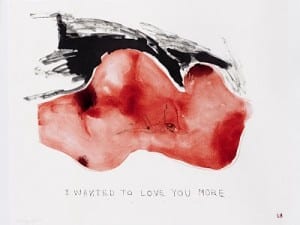A major new two-part retrospective is being staged at Paris’ Centquatre gallery and the Musee d’Art Moderne de la Ville de Paris. The subject: Keith Haring’s political line as bodied forth in his densely symbolic and instantly recognisable artwork. The show brings together some 250 pieces, some of which have never seen the inside of a gallery before, including posters created illegally by Haring on the New York subway.
Haring is perhaps most well known for his thick black line, often used to evoke perforated human beings, feral dogs and weapons. While his motifs live on – through the influence they still exert on other artists, and in Haring-inspired merchandise – the man himself does not, having died in 1990 of AIDS. This exhibition sheds deserved light on the way in which Haring exploited the artistic medium for the communication of his own political preoccupations – which, despite the twenty-three years that have elapsed since his death, are today’s. We see human beings threatened by overbearing religious institutions; a planet at the mercy of myopic industrialisation; art prostituting itself for commercial ends.
The majority of the pieces on offer are in two-dimensional form, with many using an eclectic assortment of materials ranging from canvas to tarpaulin. The show also presents a number of 3D pieces, including Sarcophagus, a life-size Mummy, daubed with Haring’s dynamic graffiti. The monumental works are to be found at the Centquatre, and include Haring’s gigantic piece Ten Commandments, his insolent and ingenious interpretation of the Decalogue.
For all its political stridency, however, this is not a stodgy show, but playful, subtle and self-ironising. An entire wall is dedicated to Haring’s phallus sketches, including one showing the Twin Towers as two giant penises. The curator ensures that we do not tire of Haring’s repetitive motifs by presenting them in ever more inventive ways – one room is blaring with eighties music, reproducing the atmosphere that Haring liked to work in, while the space in which his subway posters are shown is clinically lit, as dark and dingy as a train compartment. These are broken up by pictures of bemused New Yorkers, looking at the artist’s work in varying states of confusion.
Overall, Keith Haring: The Political Line can be classed as one of the strongest Parisian retrospectives of the year, one which has found exactly how to inform and educate its visitors, while not boring or condescending them. It is not to be missed.
Leaf Arbuthnot
Keith Haring, The Political Line, 19 April until 18 August, Musee d’Art Moderne de la Ville de Paris, 11 avenue du Président Wilson, 75116 Paris. www.mam.paris.fr
Image: Keith Haring, Brazil, 1989. © Keith Haring Foundation





